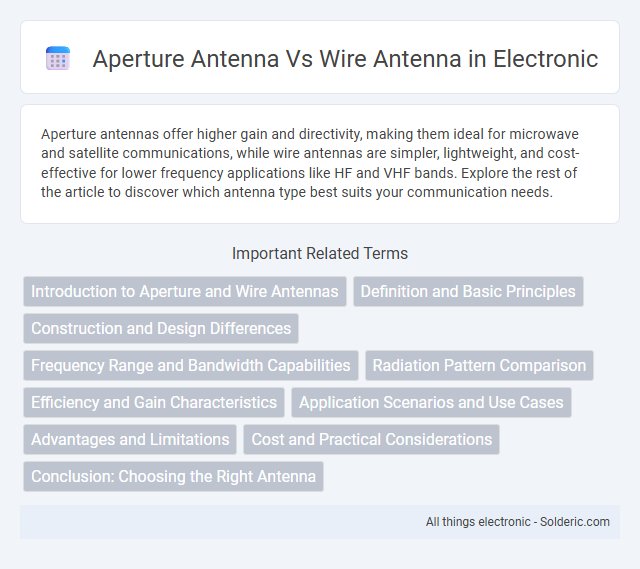Aperture antennas offer higher gain and directivity, making them ideal for microwave and satellite communications, while wire antennas are simpler, lightweight, and cost-effective for lower frequency applications like HF and VHF bands. Explore the rest of the article to discover which antenna type best suits your communication needs.
Comparison Table
| Feature | Aperture Antenna | Wire Antenna |
|---|---|---|
| Structure | Uses a physical opening or aperture (e.g., horn, parabolic reflector) | Conductive wire or element(s), such as dipoles or monopoles |
| Frequency Range | Typically higher frequencies (microwave to millimeter waves) | Wide range, from HF to UHF and beyond |
| Gain | High gain due to focused radiation | Moderate gain, depends on length and configuration |
| Beamwidth | Narrow beamwidth, high directivity | Wider beamwidth, less directional |
| Size | Large physical size, especially at lower frequencies | Compact and lightweight |
| Applications | Radar, satellite communication, microwave links | Broadcasting, HF communication, amateur radio |
| Complexity | Complex design and fabrication | Simple and easy to construct |
| Polarization | Can support various polarizations (linear, circular) | Typically linear polarization |
| Cost | Higher cost due to size and materials | Lower cost, simple materials |
Introduction to Aperture and Wire Antennas
Aperture antennas, such as horn or parabolic dish antennas, use a physical opening or aperture to direct radio waves, offering high gain and narrow beamwidth ideal for microwave and satellite communications. Wire antennas, including dipole and monopole types, primarily rely on conductive elements to radiate electromagnetic waves, making them simple, cost-effective, and commonly used for HF to UHF frequency ranges. The fundamental difference lies in the aperture antenna's use of a waveguide or reflector for enhanced directivity versus the wire antenna's reliance on resonance and element length for radiation efficiency.
Definition and Basic Principles
An aperture antenna uses a physical opening or aperture, such as a horn or slot, to direct radio waves, relying on waveguide principles for efficient energy radiation and reception. Wire antennas consist of conductive elements like dipoles or monopoles that resonate at specific frequencies, converting electrical signals into electromagnetic waves through current flow along the wires. Your choice between these antennas depends on the desired operating frequency, bandwidth, and radiation pattern, as aperture antennas typically offer higher gain and directivity compared to wire antennas.
Construction and Design Differences
Aperture antennas feature a hollow or open structure such as horns or waveguides, designed to efficiently radiate or receive electromagnetic waves through an aperture, providing high gain and directivity. Wire antennas, typically made from conductive materials like copper wires arranged in dipole or monopole configurations, rely on current distribution along the wires to radiate signals and tend to be simpler and more lightweight. Understanding these construction and design differences helps you select the appropriate antenna for your specific communication or broadcasting needs.
Frequency Range and Bandwidth Capabilities
Aperture antennas, such as horn and parabolic dishes, typically operate efficiently at higher frequencies ranging from microwave to millimeter waves, offering wide bandwidth capabilities suitable for satellite and radar communication. Wire antennas, including dipoles and monopoles, are generally optimized for lower frequency ranges like HF, VHF, and UHF, with narrower bandwidth that depends on their physical length relative to the wavelength. The design complexity of aperture antennas allows for broader operational bandwidths and improved frequency selectivity compared to the simpler structure and limited bandwidth performance of wire antennas.
Radiation Pattern Comparison
Aperture antennas typically exhibit highly directional radiation patterns with narrow beamwidths, enabling focused energy transmission and reception ideal for applications requiring long-range communication and high gain. Wire antennas, such as dipoles or monopoles, generally produce broader, less focused radiation patterns that are omnidirectional or bidirectional, suitable for short to medium-range communication with simpler design and installation. The radiation pattern of aperture antennas offers superior directivity and minimized sidelobe levels compared to wire antennas, enhancing signal strength and reducing interference in targeted directions.
Efficiency and Gain Characteristics
Aperture antennas typically offer higher efficiency and gain compared to wire antennas due to their larger effective aperture and well-defined radiation patterns. Wire antennas, while simpler and more compact, often exhibit lower gain and efficiency because of their limited aperture size and increased losses. Your choice should consider the application's need for directional gain and efficient power transmission, with aperture antennas favored for high-performance scenarios.
Application Scenarios and Use Cases
Aperture antennas excel in high-frequency applications like satellite communication and radar systems, where precise directional control and high gain are critical. Wire antennas are commonly used in HF and VHF bands for mobile, amateur radio, and broadcasting due to their simplicity, lightweight, and cost-effectiveness. Your choice depends on whether the application requires fixed, high-gain performance or flexible, portable deployment.
Advantages and Limitations
Aperture antennas offer high gain and narrow beamwidth, making them ideal for radar and satellite communications, but they tend to be large and complex with higher manufacturing costs. Wire antennas are simple, lightweight, and cost-effective, suitable for portable and low-frequency applications, yet they provide lower gain and broader radiation patterns. The choice between aperture and wire antennas depends on specific requirements for directivity, size, and budget constraints.
Cost and Practical Considerations
Aperture antennas generally incur higher costs due to their complex design, materials, and installation requirements compared to wire antennas, which are simpler and more economical to produce. Wire antennas offer versatility and ease of deployment, making them suitable for budget-conscious applications and quick setups. Your choice depends on balancing performance needs with the available budget and installation constraints.
Conclusion: Choosing the Right Antenna
Choosing the right antenna depends on your specific application requirements, such as frequency range, gain, and installation constraints. Aperture antennas provide high gain and directional focus, making them ideal for long-distance communication and radar systems, while wire antennas offer simplicity, cost-effectiveness, and broad frequency operation suitable for general-purpose use. Your decision should balance performance needs and practical factors to optimize signal quality and coverage.
aperture antenna vs wire antenna Infographic

 solderic.com
solderic.com